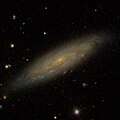|
NGC 3972
NGC 3972 is a spiral galaxy located in the northern constellation of Ursa Major. It was discovered by William Herschel on April 14, 1789.[7] This galaxy is located 66 million light years away and is receding with a heliocentric radial velocity of 846 km/s.[2] It is a member of the NGC 3992 Group of galaxies.[4]  NGC 3972 along with NGC 3977 are listed together as Holm 304 in Erik Holmberg's A Study of Double and Multiple Galaxies Together with Inquiries into some General Metagalactic Problems, published in 1937.[8] This grouping is purely optical, as NGC 3977 is about four times farther away than NGC 3972.[9] NGC 3972 is a radio galaxy, i.e. a galaxy with giant regions of radio emission extending well beyond its visible structure.[10] SupernovaeTwo supernovae have been observed in NGC 3972:
Gallery
See alsoReferences
External links
|
||||||||||||||||||||||||||||||||

